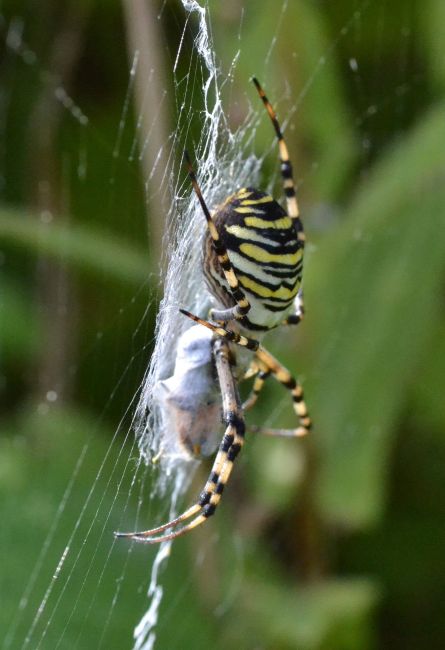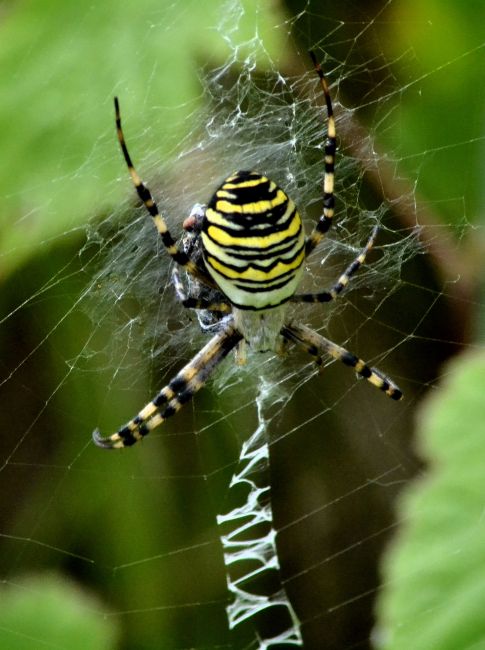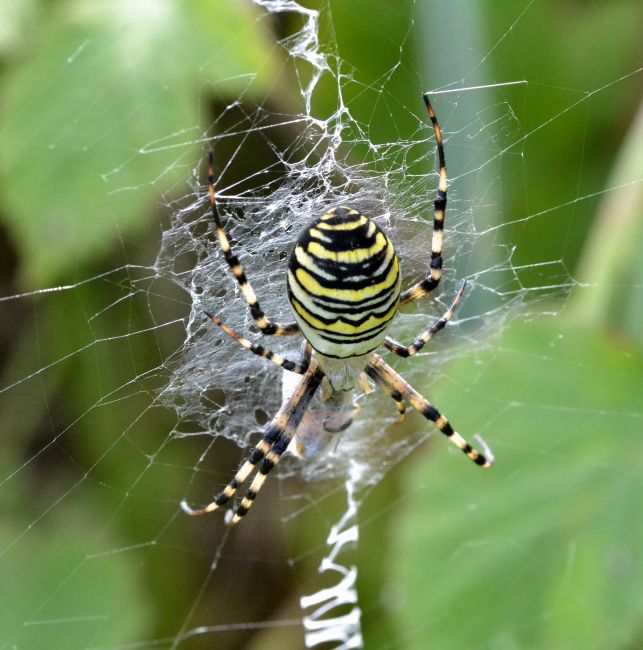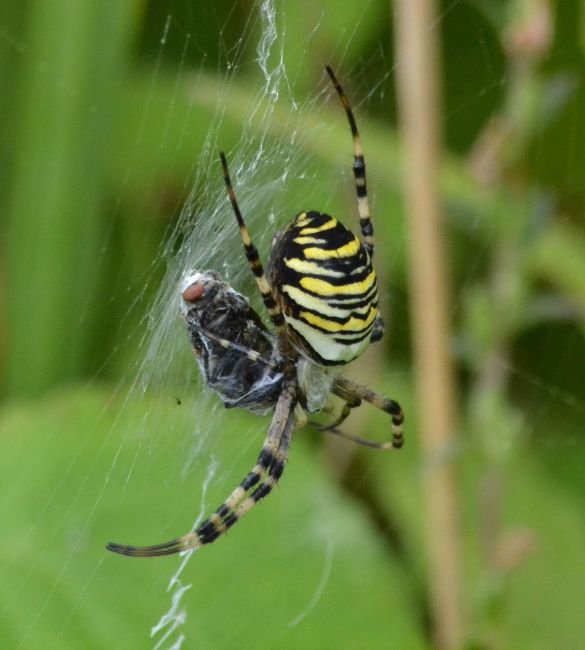The following is presented in all seriousness. Today by way of doing something quite different I enjoyed Oxfordshire’s best fringe wildlife attraction of the moment, the Radley Wasp Spider. This thing of great beauty and mystique was found within a former gravel pit complex (SU520977) six days previously by my wildlife colleague Wayne Bull (see here), then viewed and blogged subsequently by Ewan (see here). So when I ran into the latter at Farmoor Reservoir this morning and he said he was about to have another look, I gladly accepted his invitation to go along too.
This strikingly colourful arachnid, Argiope bruennichi originates from the Mediterranean region and occurs locally through much of central and northern Europe and beyond. It was first recorded in England in 1922, and through the rest of that century mostly from south coast locations. But with more recent global warming there has been a northward range expansion that has attracted some media attention. The name derives from the female of this post’s Wasp like colouring. Males are somewhat smaller and brown so hence less noticeable, even should they survive mating during which they are most often eaten alive.
Well we’ve all known one or two of those, haven’t we chaps? Today we re-located the femme fatale in question quickly, still spread-eagled across her intricate web (pictured above) low down in the vegetation to one side of a track to where my colleague led me. She was busily engaged in cocooning an ensnared fly as some of these pictures show. The large web is termed an “orb web” with an ingenious vertical zigzag pattern running down its centre, known as a stabilimentum that is said to reflect ultra-violet light to attract prey insects.
Females are roughly the same size, between 140 and 180mm long as a larger Garden Spider (Araneus diadematus), that appear in profusion almost everywhere at this time of year. The latter species varies greatly in form but is never black and yellow. The former’s crossways abdomen pattern mimicking the colouration of a wasp is a clever survival mechanism, since predators will mostly leave such stinging insects alone.
The diminutive males are typically between just 4 and 5mm in length and for the reason stated earlier very few remain by this stage of the season. To avoid being consumed sooner they build webs of their own within the edges of the larger one. There they are able to remain undetected until the occupant completes her final moult and reaches sexual maturity, when her jaws will also be softer. Then the intrepid mini-suitors dart in to take their chance but soft jaws or not invariably become a convenient snack once the business is done.
That’s the way to treat ’em, hey chapesses? I am sure there must be more scientific if less entertaining explanations for all this. One is that males of a certain size are able to “plug” the female after mating with their entire bodies to prevent any other male from fertilising her eggs. But perhaps the divas in question might not wish to grant such exclusivity and so tuck in anyway. Maybe it’s time to move on!
Since Wasp Spiders have a particular liking for Grasshoppers as a food item they are rarely found in gardens but more usually unmanaged rough grassland in the countryside. There the web is typically spun in long grass a little above ground level, as with today’s example. Upon a prey item being caught in the web it is immobilised by being wrapped in silk, then bitten and injected with a paralysing venom.
The above picture shows our subject dealing with a newly trapped fly in that way. Being quite pleased with these images I wanted to return with my macro lens and so re-visited in the afternoon with another wildlife colleague, Sally who also wished to see this highly attractive spider. By then the food item was fully cocooned (pictured below), but the morning’s telephoto pictures are probably better. I believe the three of us are the only Oxon birders, other than its finder to take in this alternative local experience so far.


The subject of this post does not, however always receive such a good press as herein. Cue the DAILY STAR from 9th September 2020:
—————————
Sinister wasp spiders invading south east England
– and yes, they do bite
A chilling new creepy-crawly blitzing Britain is every bug-haters’ worst nightmare – because it is a combination of a wasp and spider.
Wasp spiders usually lurk in remote parts of continental Europe and Africa. But because wild grasses have been allowed to grow in the UK during lockdown the exotic species have marched across the English Channel and taken up residence.
The sinister-looking creatures are set to terrorise staycationers as they resemble two of Britain’s most-hated bugs. Luckily, though the spiders bear distinctive wasp-style stripes, they do not share their ability to fly. But they do bite.
Experts say a wasp spider nip can be painful but is not poisonous. They surfaced in Suffolk after councillors chose 40 places to ‘re-wild’ by leaving grass uncut during the pandemic. Within weeks all manner of bugs, birds and insects had made the hotspots their homes.
The spiders have mated and flourished, no mean feat for the males which are just a quarter of the size of females and often eaten by them during sex.
< An unnamed here > East Suffolk Council cabinet member for the environment, was delighted to spot one in his own garden after he let part of his lawn grow wild. “The wasp spider is visually nice,” he said. “It’s the biggest spider I have ever seen. “
Despite the spider’s eye-catching appearance < he > said most people seemed happy to welcome more exotic species of wildlife and the council plans to increase the number of wild grass sites to 100 over the next year.
“People have really engaged with nature more during the coronavirus lockdown and it’s really noticeable that people appreciate it in their own community or garden,” he said.
——————————–
Hmmm … having now been properly introduced, I have to say I rather like them too. For the record, this similar looking number (above) that I stumbled upon in Morocco in November 2015 is the biggest spider that I myself have ever seen. This lady, as I’m now sure she must have been was the size of my hand … so for “terrified staycationers” her kind could be a further “nemesis divine” were they also to “march across” to these shores. ID anyone?




